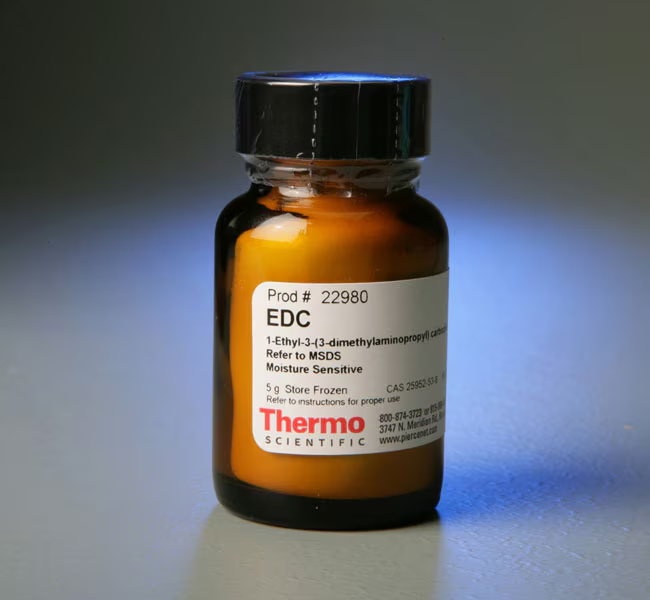
Thermo Scientific Pierce EDC is a carboxyl- and amine-reactive zero-length crosslinker. EDC reacts with a carboxyl group first and forms an amine-reactive O-acylisourea intermediate that quickly reacts with an amino group to form an amide bond with release of an isourea by-product. The intermediate is unstable in aqueous solutions and so two-step conjugation procedures rely on N-hydroxysuccinimide (NHS) for stabilization. Failure to react with an amine will result in hydrolysis of the intermediate, regeneration of the carboxyl, and release of an N-substituted urea. A side reaction is the formation of an N-acylurea, which is usually restricted to carboxyls located in hydrophobic regions of proteins.
Thermo Scientific No-Weigh products are specialty reagents provided in a pre-aliquoted format. The pre-weighed packaging prevents the loss of reagent reactivity and contamination over time by eliminating the repetitive opening and closing of the vial. The format enables use of a fresh vial of reagent each time, eliminating the hassle of weighing small amounts of reagents and reducing concerns over reagent stability.
Characteristics of EDC:
• Reactive group: carbodiimide
• Reaction target: activates carboxyl groups to conjugate to amino groups (primary amines)
• Several conjugation strategies—react EDC alone with target groups or include NHS or Sulfo-NHS to increase reaction efficiency or to stabilize active intermediate for later reaction to amines
• Neutral linkage—forms neutral amide bonds between carboxyls and amines
• Water-soluble reagent—add directly to reactions in aqueous, physiological buffers
• Soluble reaction byproducts—easily removed by washing with water or dilute acid
• High-purity, crystalline reagent—use to create high-quality, activated derivatives
Properties of EDC
• Molecular formula: C8H17N3·HCl
• Molecular weight: 191.7
• Spacer arm length: 0 Å
• CAS Number: 25952-53-8
• Reactive groups: carbodiimide
• Reactivity: Forms active intermediate with carboxyl groups at pH 4.7–6.0 (optimum), then intermediate reacts with primary amines
1-Ethyl-3-[3-dimethylaminopropyl]carbodiimide hydrochloride (EDC or EDAC) is a zero-length crosslinking agent used to couple carboxyl groups to primary amines. This crosslinker has been used in diverse applications such as forming amide bonds in peptide synthesis, attaching haptens to carrier proteins to form immunogens, labeling nucleic acids through 5' phosphate groups and creating amine-reactive NHS-esters of biomolecules. EDC reacts with a carboxyl to form an amine-reactive O-acylisourea intermediate. If this intermediate does not encounter an amine, it will hydrolyze and regenerate the carboxyl group. In the presence of N-hydroxysulfosuccinimide (Sulfo-NHS), EDC can be used to convert carboxyl groups to amine-reactive Sulfo-NHS esters. This is accomplished by mixing the EDC with a carboxyl containing molecule and adding Sulfo-NHS.
Applications:
• Conjugate carboxyl and amino groups among peptides and proteins
• Couple haptens to immunogenic carrier proteins (e.g., attach a peptide to KLH)
• Immobilize peptide antigens to affinity-purify antibodies
• Create NHS-activated, amine-reactive labeling compounds
• Crosslink proteins to carboxyl coated beads or surfaces
• Activate nanoparticles with amine-reactive Sulfo-NHS esters
• DNA labeling through 5' phosphate groups (see Tech Tip #30)
Product References:
Crosslinker Application Guide -- search for recent literature references for this product
| Code | Description |
|---|---|
| 22980 | Catalog Number: 22980 |
| A35391 | Catalog Number: A35391 |
| 77149 | Catalog Number: 77149 |
| 22981 | Catalog Number: 22981 |

